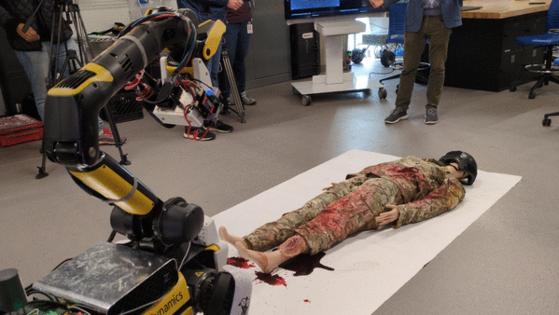AI trained robots, drones, team up with emergency rescue
Published in News & Features
In a simulated natural disaster, robotic drones from the University of Maryland’s RoboScout Team arrived first, scanning the area for survivors. They beamed patients’ locations to robot dogs and medics on the ground to quickly find, triage and treat the most critically injured people first.
“When we talk about robot triage, we’re talking about using drones and robots to assess the severity of injuries,” said Derek Paley, professor of aerospace engineering at UMD and principal investigator for RoboScout. “This would be used when there’s a scenario where there are more patients than medics.”
The RoboScout team is participating in the second year of a three-year Defense Advanced Research Projects Agency grant program called the DARPA Triage Challenge. The large-scale simulations took place last month in Perry, Georgia, and they demonstrated their abilities on Oct. 16 at UMD’s Maryland Robotics Center.
Triage — the process of quickly assessing multiple patients to determine who needs medical care first — is one of the most critical parts of responding to a mass casualty incident, according to the challenge website. During disasters such as earthquakes, major accidents or attacks, there are often far more victims than available medical responders.
This year, their simulations were more difficult, including night scenarios, said Project Engineer Josh Gauss, who co-leads the project along with Paley. Gauss helped design the autonomous drones that arrive at the scene first and locate any bodies or injured people.
During their demonstration, their Boston Dynamics Spot dog, Apollo, approached an injured person — a mannequin — and announced, “I’m here to help. Do you need assistance?” and scanned the person for vital signs.
Apollo, carrying an onboard AI computer, could also speak with a patient using a large language model chat system before sending their assessment to medics’ phones.
“They can also call out to the medic when they find a person with critical injuries,” Paley said. “That’s valuable, because a medic is usually working very quickly to save lives. Their hands are busy; their eyes are busy, but they can still hear. They’ve told us they find that very helpful.”
The medic can then prioritize the next critical patient for treatment, with the patient’s vitals already displayed on their phone. The robots can also stand by and monitor a patient, reporting any changes in condition. Paley said robots will someday provide care and help stabilize a patient. For safety in their simulations, which include human actors as well as high-tech mannequins, they maintain a two-meter distance.
The team improves the performance of their AI and language models with each simulation, Paley said, with help from partners including medical personnel from the University of Maryland School of Medicine in Baltimore.
“Working with their medics has been really eye-opening for us,” he said. “They provide valuable feedback to help improve our responses.”
Paley estimated that robots and drones will be active first responders within a few years as data from these simulations helps shape best practices for real-world disasters.
_____
©2025 Baltimore Sun. Visit baltimoresun.com. Distributed by Tribune Content Agency, LLC.







Comments